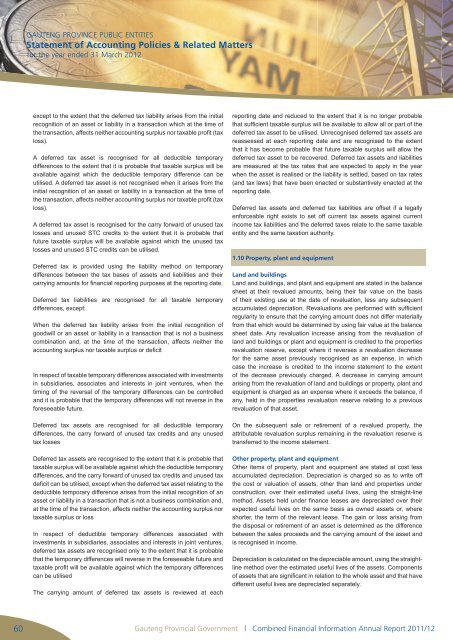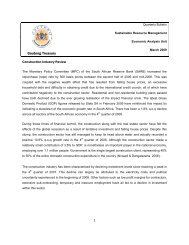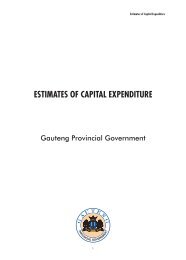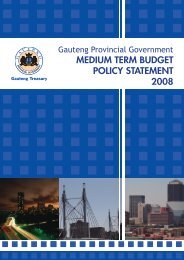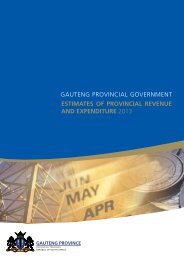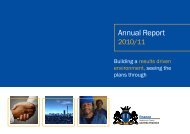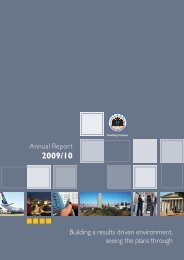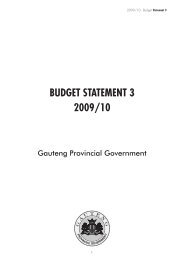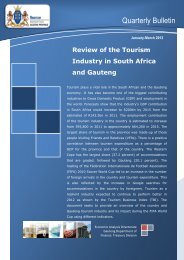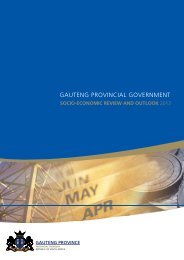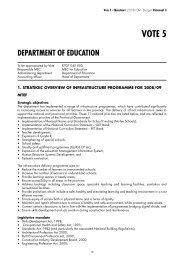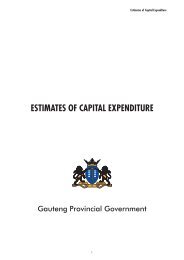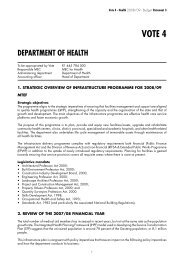ACFI 2011/12.indd - Gauteng Provincial Treasury
ACFI 2011/12.indd - Gauteng Provincial Treasury
ACFI 2011/12.indd - Gauteng Provincial Treasury
Create successful ePaper yourself
Turn your PDF publications into a flip-book with our unique Google optimized e-Paper software.
GAUTENG PROVINCE PUBLIC ENTITIESStatement of Accounting Policies & Related Mattersfor the year ended 31 March 2012except to the extent that the deferred tax liability arises from the initialrecognition of an asset or liability in a transaction which at the time ofthe transaction, affects neither accounting surplus nor taxable profi t (taxloss).A deferred tax asset is recognised for all deductible temporarydifferences to the extent that it is probable that taxable surplus will beavailable against which the deductible temporary difference can beutilised. A deferred tax asset is not recognised when it arises from theinitial recognition of an asset or liability in a transaction at the time ofthe transaction, affects neither accounting surplus nor taxable profi t (taxloss).A deferred tax asset is recognised for the carry forward of unused taxlosses and unused STC credits to the extent that it is probable thatfuture taxable surplus will be available against which the unused taxlosses and unused STC credits can be utilised.Deferred tax is provided using the liability method on temporarydifferences between the tax bases of assets and liabilities and theircarrying amounts for fi nancial reporting purposes at the reporting date.Deferred tax liabilities are recognised for all taxable temporarydifferences, except:When the deferred tax liability arises from the initial recognition ofgoodwill or an asset or liability in a transaction that is not a businesscombination and, at the time of the transaction, affects neither theaccounting surplus nor taxable surplus or defi citIn respect of taxable temporary differences associated with investmentsin subsidiaries, associates and interests in joint ventures, when thetiming of the reversal of the temporary differences can be controlledand it is probable that the temporary differences will not reverse in theforeseeable future.Deferred tax assets are recognised for all deductible temporarydifferences, the carry forward of unused tax credits and any unusedtax lossesDeferred tax assets are recognised to the extent that it is probable thattaxable surplus will be available against which the deductible temporarydifferences, and the carry forward of unused tax credits and unused taxdefi cit can be utilised, except when the deferred tax asset relating to thedeductible temporary difference arises from the initial recognition of anasset or liability in a transaction that is not a business combination and,at the time of the transaction, affects neither the accounting surplus nortaxable surplus or lossIn respect of deductible temporary differences associated withinvestments in subsidiaries, associates and interests in joint ventures,deferred tax assets are recognised only to the extent that it is probablethat the temporary differences will reverse in the foreseeable future andtaxable profi t will be available against which the temporary differencescan be utilisedThe carrying amount of deferred tax assets is reviewed at eachreporting date and reduced to the extent that it is no longer probablethat suffi cient taxable surplus will be available to allow all or part of thedeferred tax asset to be utilised. Unrecognised deferred tax assets arereassessed at each reporting date and are recognised to the extentthat it has become probable that future taxable surplus will allow thedeferred tax asset to be recovered. Deferred tax assets and liabilitiesare measured at the tax rates that are expected to apply in the yearwhen the asset is realised or the liability is settled, based on tax rates(and tax laws) that have been enacted or substantively enacted at thereporting date.Deferred tax assets and deferred tax liabilities are offset if a legallyenforceable right exists to set off current tax assets against currentincome tax liabilities and the deferred taxes relate to the same taxableentity and the same taxation authority.1.10 Property, plant and equipmentLand and buildingsLand and buildings, and plant and equipment are stated in the balancesheet at their revalued amounts, being their fair value on the basisof their existing use at the date of revaluation, less any subsequentaccumulated depreciation. Revaluations are performed with suffi cientregularity to ensure that the carrying amount does not differ materiallyfrom that which would be determined by using fair value at the balancesheet date. Any revaluation increase arising from the revaluation ofland and buildings or plant and equipment is credited to the propertiesrevaluation reserve, except where it reverses a revaluation decreasefor the same asset previously recognised as an expense, in whichcase the increase is credited to the income statement to the extentof the decrease previously charged. A decrease in carrying amountarising from the revaluation of land and buildings or property, plant andequipment is charged as an expense where it exceeds the balance, ifany, held in the properties revaluation reserve relating to a previousrevaluation of that asset.On the subsequent sale or retirement of a revalued property, theattributable revaluation surplus remaining in the revaluation reserve istransferred to the income statement.Other property, plant and equipmentOther items of property, plant and equipment are stated at cost lessaccumulated depreciation. Depreciation is charged so as to write offthe cost or valuation of assets, other than land and properties underconstruction, over their estimated useful lives, using the straight-linemethod. Assets held under fi nance leases are depreciated over theirexpected useful lives on the same basis as owned assets or, whereshorter, the term of the relevant lease. The gain or loss arising fromthe disposal or retirement of an asset is determined as the differencebetween the sales proceeds and the carrying amount of the asset andis recognised in income.Depreciation is calculated on the depreciable amount, using the straightlinemethod over the estimated useful lives of the assets. Componentsof assets that are signifi cant in relation to the whole asset and that havedifferent useful lives are depreciated separately.60 <strong>Gauteng</strong> <strong>Provincial</strong> Government | Combined Financial Information Annual Report <strong>2011</strong>/12


